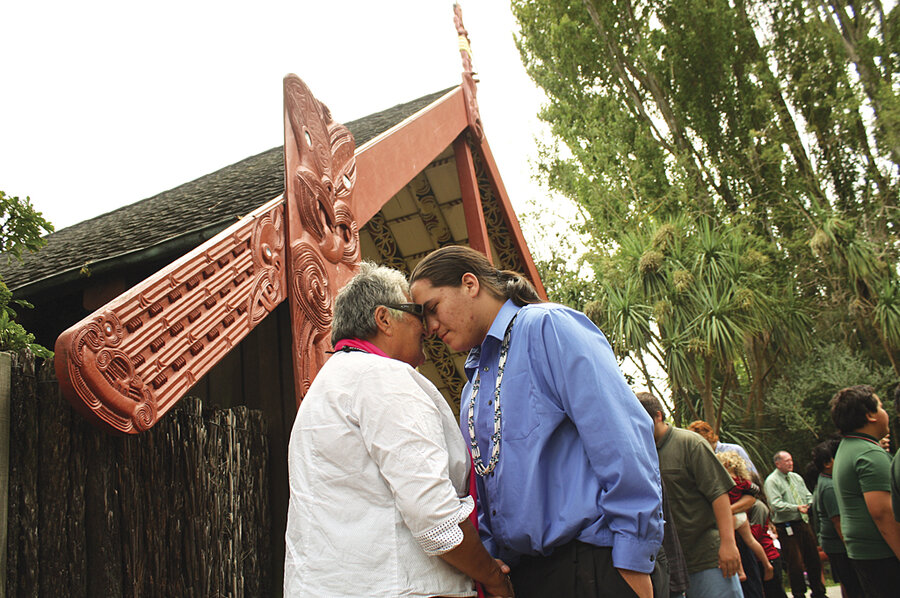How a native American tribe got their salmon back, by way of New Zealand
Loading...
| Christchurch, New Zealand
• A local, slice-of-life story from a Monitor correspondent.
The eel was there, just as the Maori said it would be. About two feet long and colored a misty sapphire, the longfin eel billowed in place beneath the glassy waters as the Winnemem Wintu watched in rapt silence.
With the foothills of New Zealand’s Southern Alps looming in the distance, about two dozen members of the northern California tribe had lined the banks to peer into the shallow creek. Many aimed video or still cameras down at the South Island waterway, a traditional spawning ground for the country’s modest chinook salmon fishery. The small tribe had traveled across the Pacific to commune with their sacred salmon, which they hadn’t seen in more than 60 years.
But there to greet them instead was an eel, the sacred fish of their native Maori hosts. Some said its presence was a good omen, a messenger sent as a welcome by a Taniwha, a guardian spirit of the water.
Soon, the first salmon appeared, spectral blurs of gray floating past. Spiritual leader Caleen Sisk-Franco clapped her hands, her eyes welling with tears.
“They’re so small!” she said with motherly concern. “When we take them home, they’ll get bigger.”
In the native American tribe’s creation story, the salmon gave their voice to the Winnemem, forever binding the people to the fish that spawned in the McCloud River. But the Winnemem had been separated from their salmon since World War II when the newly erected Shasta Dam, a 600-foot concrete curtain, diverted the traditional chinook salmon run away from the McCloud.
“When our people would come together for the salmon harvest, relationships would be established. When the salmon died after spawning, they provided nutrients to our lands and to our bodies,” Ms. Sisk-Franco said. “Blocking that river really changed our lives.”
But in 2005, a New Zealand professor contacted the tribe via e-mail to say, “We have your salmon.” New Zealand salmon, it turned out, were spawned in the late 19th century from eggs cultivated at the Baird Station Hatchery on the McCloud River.
With the news, the Winnemem hatched an unorthodox plan to restore the McCloud salmon run with eggs from New Zealand.
Since the Shasta Dam isn’t going anywhere, salmon hatched in the McCloud would have to be trapped and transported by truck around the dam. The Winnemem have, however, proposed that California water officials connect a natural channel that runs from the Sacramento River to the Shasta reservoir. Salmon could swim up the channel, past the dam, and be guided into the reservoir at the mouth of the McCloud. Talks between the tribe and state and federal officials are under way.
“We really believe if they’re that close and can smell those McCloud waters, they’ll find their way home,” tribal headman Mark Franco said.
Despite restricted finances, 30 members of the tribe boarded a plane to New Zealand this spring after raising money through Facebook and holding chili feeds to fund the trip.
Welcomed by Maori tribes, the Winnemem performed a four-day salmon ceremony by the Rakaia River and visited a salmon hatchery, where they were given big buckets of swirling salmon hatchlings to release into a nearby creek.
During the two-week visit, the Maori and Winnemem bonded over large feasts, laughter, and a common struggle to preserve their culture and lands against the forces of assimilation.
“Me and my people are so much stronger from knowing them. I hope they’re stronger from knowing us,” said Pauline Reid of the Waitaha, one of the hosting Maori tribes.
“I have no doubt their salmon survived here because the eels were here to help them,” said Ms. Reid. “They knew the Winnemem would come back for them.”
Related:





